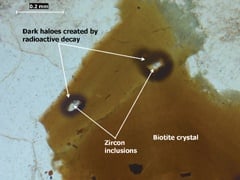In this regular column, Consultant Barry Hunt answers reader enquiries. If you have a question, email it to: nss@qmj.co.uk marked for Barry’s attention
Q: I have been told granite worktops can give off radon gas. Is this true? And if it is, is it a problem?
The issue of the radioactivity of granite, and specifically the production of radon gas which is linked to lung cancer, sets alarm bells ringing, pulses racing and heads spinning. The panic button has been pressed several times on this, most recently in July 2008 when the New York Times ran an article that was picked up by several US TV stations.
It is a big subject, so I am going to answer it across two issues of Natural Stone Specialist, starting here and concluding next month.
First, it should be noted that all materials contain radioactive traces that form a part of the background radiation in the world. However, the fleeting life of radon is as a gas, which means it can become mobile and therefore respirable, which can lead to the noted health issues.
Radiation from solid sources typically has little effect unless you are in very close proximity or direct contact with the material because the effects rapidly diminish with distance. A good example is low-sodium table salt. It often contains an amount of potassium-based salt that will always have a proportion of a radioactive isotope (K40) that will set a Geiger counter buzzing. This same potassium is rumoured to make bananas appear radioactive. The predominant beta radiation with a bit of gamma radiation is considered harmless and unavoidable and actually crops up in almost all produce.
Place a Geiger counter on a piece of granite and the close proximity radiation it will pick up will be mostly beta radiation – or what many know as electrons – from the same radioactive potassium (K40) because it forms a significant constituent of the alkali feldspar crystals that can constitute up to 80% of the rock mass.
Please note that Geiger counters do not distinguish between different types of radiation.
Hot spots of radiation may be found where there are traces of uranium or other radioactive materials in the stone. Biotite mica, a common constituent of granite and other rocks, often exhibits zircon crystal inclusions with dark haloes that have altered the properties of the biotite as a consequence of the radioactive decay of typically uranium and thorium traces within the zircon.
This issue of radon gas associated with granite worktops has continued to bubble because there was no available peer-reviewed scientific research into the matter.
However, in late August 2009 there was the advanced online publication of a two-part paper by independent scientists specifically covering this issue, which concluded that both radiation and radon gas derived from natural stone counter tops presented a negligible risk to human health. This information now appears to be reflected in advice given on the US Environmental Protection Agency’s website.
It must be said that this study presently stands alone and has limited scope as it has investigated only a relatively small number of stones. However, it has highlighted several interesting issues, some expected, some less so, which I will explore next month.
Barry Hunt is a Chartered Geologist and Chartered Surveyor who has spent 20 years investigating issues relating to natural stone and other construction materials. He now runs IBIS, an independent geomaterials consultancy undertaking commissions worldwide to provide consultancy, inspection and testing advice. Tel: 020 8518 8646
info@ibis4u.co.uk

